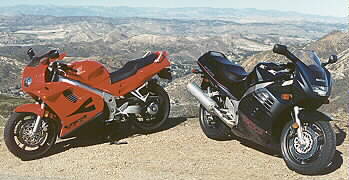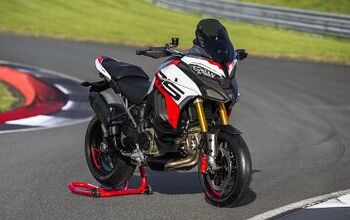Church of MO: 1996 Suzuki RF900 Vs Honda VFR750
And in the last century, the people were obsessed with sportybikes and roadracing, and their unnatural lust for these abominable things caused them to be constantly splitting hares on rural roads instead of welcoming aged visitors on V-Stroms and BMW GSs into the motorcycling community. In truth I say unto you, the RF900 and VFR750 were virtual saints compared to the wicked performance machines that would replace them. Yet verily, no one would listen, and so we shake off the dust from our feet as we leave that town behind. Wait, what? Never mind. What’s important is the Honda’s new digital clock.
Two For The Real World
What kinds of riding do you do? Commuting? Touring? Canyon carving? If you’re like most riders, the answer is all of the above. With the cost of new bikes these days, the luxury of having a different bike for each application is simply unaffordable. On the other hand, when manufacturers try to make one bike that is all things to everyone, something usually gets lost in the final execution. But fortunately, that doesn’t stop them from trying.We gathered up two of the most competent all-rounder motorcycles made today — the Honda VFR750F and Suzuki’s RF900R — for a little head-to-head comparison: Which is the best at every type of street riding?
Despite the 150cc capacity difference, on paper these bikes look similar: Both have water-cooled 16-valve four cylinder motors with perimeter frames, fat 17 inch wheels and chain final drive. They both weigh about 450 pounds and hold 5.5 gallons of fuel. Even the prices are similar with the Honda undercutting the Suzuki by just 100 dollars. On the road though, differences become apparent.
Both bikes start easily, the Suzuki’s choke requiring a little more attention than the Honda’s. Both can be ridden away almost immediately with no hesitations or flat spots as the motor comes up to operating temperature. Once warm, the carburetion of both bikes is near perfect.Shifting the Honda’s close-ratio six speed transmission is smooth and easy; it’s probably the most refined tranny in the business. The Suzuki’s long-legged five speed requires less shifting but has a short throw between gears requiring a more conscious effort on the lever for positive shifts.
From a distance, both bikes appear to offer a sport-oriented riding position. Though both bikes mount the handlebars above the top triple clamp, the Suzuki’s low rubber-mounted bars bend the rider closer to the tank putting more weight on his wrists. Footpegs are high-mounted and the result is a riding position akin to more sport-oriented models. Getting off the RF and onto the VFR accentuates the difference in rider ergonomics. Low pegs and fairly high bars put the Honda rider in a more comfortable position for controlling a motorcycle over interminably long interstates or for a long daily commute. A ride through the canyons reveals more differences. With the sportier riding position and the bigger motor, the Suzuki should have had the advantage when the going got going, but that just wasn’t the case. The Honda rider was always able to run away and hide from the heavy-handling Suzuki — despite the RF having more-adjustable suspension units. New for 1996, Suzuki added adjustable rebound damping control atop the 43mm cartridge-style forks to augment the spring preload adjusters, yet the action of the forks remains harsh. With the forks set up from the factory, the front end has a tendency to shimmy and shake its way over mid-corner bumps and pavement seams. Softening the preload and damping made for a smoother street ride, but didn’t help its cornering attitude.
The sprightly VFR, though slightly under-sprung, gave excellent feedback through the front end and was much more confidence-inspiring when fully leaned over.
Turning the Honda from full tilt to back again takes less effort than the Suzuki, thanks to the profiles of its sticky Dunlop rubber. Four inches of trail may help explain the Suzuki’s lazy steering manners.
In addition to the handling differences, both bikes make power in different ways due to the different configurations of their engines. The RF motor uses most of the hardware of the almighty GSXR1100 — cases, crankshaft and transmission — but with a smaller bore and stroke of 73.0 x 56.0 mm for a displacement of 937cc. Compression ratio is 11.3:1 thanks to the cylinder head sourced from its smaller sibling the RF600, but the 900 gets larger ports and valves. Carburetors are also shared between the two RFs, both bikes sucking fuel through a bank of four 34mm downdraft mixers. The RF’s motor is solidly mounted to the twin-spar pressed steel frame but uses a rubber mount between the head and frame to help reduce intrusive vibration. It didn’t completely work. At speeds above 5000 rpm, the motor’s buzzing is fed through the rubber-mounted bars and footpegs straight to the rider. Thanks to the tall gearing, typical freeway speeds in top gear are well below the point of vibration, but on a two-up ride through the hills, the buzzing from the higher engine speeds can be fatiguing. A pair of four-piston Nissin calipers grab full floating 310mm rotors with the usual excellence of Suzuki brakes. Very strong initial bite, good feedback and powerful retardation.Where the Suzuki looks to the GSXR1100 for ideas, the VFR needs look no further than the podium of just about any AMA National Superbike race in 1995 for inspiration. The 748cc 90 degree liquid-cooled V-4 is a relative once removed of the exotic and fast RC-45. Camshafts geared directly to the crankshaft. Four shim-under-bucket valves per cylinder. A slick-shifting close-ratio six speed gearbox. Narrow twin-spar frame made from lightweight and strong extruded aluminum. And the single-sided aluminum Pro-Arm swingarm straight off the experimental Elf 500cc Grand Prix bike.
With this much racing heritage, it is surprising that the VFR is as comfortable as it is. Honda went to great lengths to ensure that their sole 750 sport bike would be first and foremost a street bike, not a race bike with lights. Comfortable ergonomics complement a real-world powerband — torquey and responsive from right off idle — while the stiff chassis and compliant suspension components help keep the bike stable at speed. Fit and finish is exemplary. Subtle touches like quarter-turn fairing fasteners, space under the seat to accommodate a U-lock and a well-designed centerstand that rarely touched down while cranked over mid-corner add to the bike’s street appeal.Though not as powerful as those of the Suzuki, the Honda’s Nissin twin-piston calipers grab their 296mm rotors with enough strength to stand the bike on its nose, yet they’re progressive enough to trail-brake the red rocket right to the apex of your favorite corner. Scoops in the upper fairing direct cool air to the engine compartment where a bank of four 34mm flat-slide CV carbs feed fuel to the 70 x 48.6mm 748cc V-four. Tuned for low-end torque, throttle response and around town power are excellent, yet there is still a top-end hit when the tach reaches the high side of 7000 rpm. Vents in the rear side panel help disperse engine heat and a removable solo seat cowl is standard equipment. The r
ear turn signals are incorporated into the brake light area giving a clean look to the rear end and the trick single-sided swingarm makes chain adjustments and tire changes a breeze. When it came right down to deciding which bike was going to be declared best overall, we really had to look no further than the dash of the Honda. With everything else the VFR had in its favor, what gave Honda the nod was the digital clock right there above the tach.
Specifications
Honda VFR750FPrice: $8,999
Engine: dohc, 16-valve, V-Four
Bore x stroke: 70.0 X 48.6
Displacement: 748cc
Carburetion: (4)34mm Keihin
Transmission: 6-speed
Wheelbase: 57.9 in.
Seat height: 31.5 in.
Fuel capacity: 5.5 gal.
Claimed dry weight: 465.2 lbs.
Suzuki 1996 RF900RT
Price: $9,099
Engine: dohc, 4-valve, inline-four
Bore x stroke: 73mm x 56mm
Displacement: 937cc
Carburetion: Four 36mm Mikuni BDST
Transmission: 5-speed
Wheelbase: 56.7 in.
Seat height: 31.7 in.
Fuel capacity: 5.5 gal.
Claimed dry weight: 447 lbs
More by John Burns



































Comments
Join the conversation
Damn, I remember when this review came out. Getting old... :o
I used to see a handful of RF's up at Newcombs in the early oughts, none now. I guess most must've rusted out somewhere or been cannibalized for scrap by now. Great performing bikes but not lasting. Still see a few pre-Vtec VFRs around ....